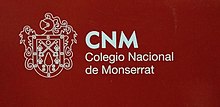Colegio Nacional de Monserrat
| Colegio Nacional de Monserrat | |
|---|---|
 | |
| Address | |
 | |
Obispo Trejo 294 , Argentina | |
| Coordinates | 31°25′07″S 64°11′13″W / 31.41861°S 64.18694°WCoordinates: 31°25′07″S 64°11′13″W / 31.41861°S 64.18694°W |
| Information | |
| Type | Public secondary |
| Motto | En virtud y Letras |
| Established | 1687 |
| Founder | Father Ignacio Duarte Quirós, Society of Jesus |
| Rector | Aldo Guerra |
| Gender | Coeducational |
| Enrollment | 1,589 (high school)[1] 500 (middle school)[2] |
| Campus | Urban |
| Athletics | Basketball, fencing, soccer |
| Mascot | Duende |
| Nickname | Monse |
| Affiliation | National University of Córdoba |
| Former names | Real Colegio Convictorio de Nuestra Señora de Monserrat · Real Universidad de San Carlos y de Nuestra Señora de Monserra |
| Notable alumni | Ramón J. Cárcano, Juan José Castelli, José Figueroa Alcorta, Gregorio Funes, Leopoldo Lugones, Dalmacio Vélez Sársfield |
| Website | www |


Colegio Nacional de Monserrat is a public college preparatory high school in Córdoba, Argentina. Patterned after the European gymnasium, the school is the second oldest of its type and one of the most prestigious in Argentina.
Overview[]

The College of Monserrat includes both a high school. The former is organized in nine departments: Philosophy, Social Sciences, History/Geography, Letters, Exact Sciences, Natural Sciences, Arts, Physical Education, and Humanities.[3] The school maintains the Professor Alfredo Ruibal Library, with almost 20,000 volumes,[4] and the Historical Museum.[5]
The school is administered by a Secondary Educational Level Advisory Board composed of the Director of the college (who presides), the Academic Deputy, a Regent, the teaching faculty (represented by nine members, six professors, two tutors, and a professor or teacher as faculty representative), two student representatives, a non-faculty staffer, and a parent.
The Middle School Level is governed by the Director, a Deputy, and a Regent, as well as a delegation of three teachers, an assistant teacher, and a student representative.[6]
History[]
Parochial era[]
The Real Colegio Convictorio de Nuestra Señora de Monserrat (Royal Boarding School of Our Lady of Montserrat) was founded in Córdoba on August 1, 1687, by the Society of Jesus. Its founder and first director was Father Ignacio Duarte Quirós, a Córdoba priest who volunteered and donated all his property to that effect. King Charles II of Spain signed the decree authorizing the establishment, whose implementation was entrusted to the Governor of Cordóba, Captain Tomás Félix de Argandoña. The college began operations as a boarding school on April 10, 1695, and was ultimately awarded a permanent certification by King Philip V, on December 2, 1716.[6]
The college was transferred to the Franciscan Order upon the 1767 Papal suppression of the Society of Jesus. The college was moved from the Duarte House to the current location, and its relocation was completed on February 9, 1782.
The institution was transferred in 1807 to Secular Clergy, pursuant to a Royal Decree of 1800 signed by King Charles IV of Spain by which he created the "Royal University of San Carlos and Our Lady of Montserrat." This new charter, which included what later became the National University of Córdoba, was accompanied by major curricular reforms enacted by the Rector of the University and College, Dean Gregorio Funes.[6]
Public era[]
The College and the University were nationalized in 1854. The former was converted from a boarding school into a secondary school in 1858, and under the aegis of the "National School" system administered by the National Institute of Public Instruction (later the Ministry of Education) from 1881 onward.[7] A new building was commissioned by Dr. Eusebio de Bedoya, and completed in 1864.[8]
The school was made an affiliate of the University in 1907. The building was adorned in 1927 with Spanish Colonial Revival doorways, windows, and fixtures during a renovation commissioned by Rector Rafael Bonet, and designed by Jaime Roca. monument to its founder, Father Ignacio Duarte Quirós, was unveiled in the central courtyard in 1937 (the 250th anniversary of the school's founding). The College of Monserrat was declared a National Historic Monument on July 14, 1938.[8] The Monserrat College became a center of nationalist and conservative agitation in subsequent decades.[9] The college newspaper, El Pampero (later renamed Pampero Cordubensis) was established by fascist writer Enrique Osés,[10] and became a leading nationalist publication prior to the 1943 coup d'état.[11]
The institution, an all-boys school throughout its history, was made coeducational by order of the University in 1997; the school's total enrollment in 2010 included, for the first time, more girls than boys.[1] The Jesuit Block of Córdoba, which includes the campus, was declared a World Heritage Site by UNESCO on November 28, 2000.[12]
See also[]
References[]
- ^ Jump up to: a b "Hay más chicas que varones en el Monse". Día a Día.
- ^ "Institucional". Colegio Nacional de Montserrat.
- ^ "Departamento de materias afines". Colegio Nacional de Monserrat. Archived from the original on 2012-03-26. Retrieved 2011-07-03.
- ^ "Biblioteca". Colegio Nacional de Monserrat.
- ^ "Museo Histórico del Colegio". Colegio Nacional de Monserrat.
- ^ Jump up to: a b c "Historia del Colegio". Colegio Nacional de Monserrat. Archived from the original on 2011-06-27. Retrieved 2011-07-03.
- ^ "Cronología Educativa". Secretaría de Gabinete.
- ^ Jump up to: a b "Colegio Nacional de Monserrat". Pampero Cordobensis.
- ^ Sandra McGee Deutsch (1999). Las Derechas: The Extreme Right in Argentina, Brazil, and Chile, 1890-1939. Stanford University Press.
- ^ Rock, David (1993). Authoritarian Argentina. University of California Press.
- ^ "Enrique P. Oses, in memoriam". Pampero Cordubensis.
- ^ "Jesuit Block and Estancias of Córdoba". UNESCO.
- Secondary schools in Argentina
- Buildings and structures in Córdoba, Argentina
- Educational institutions established in the 1680s
- School buildings completed in 1864
- Spanish Colonial Revival architecture
- National Historic Monuments of Argentina
- Education in Córdoba Province, Argentina
